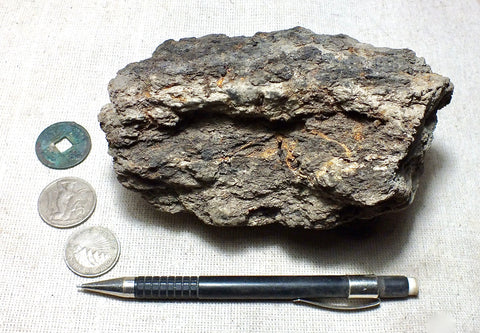peat - silty peat from the San Andreas fault zone, formed in a marsh that dried out roughly a century ago - hand/display specimen
$ 9.50
This silty peat was collected from a former marsh along Pallett Creek in the San Andreas fault zone, Los Angeles County, California
Peat is formed by partial decomposition of plant material under acidic conditions. With burial and compression, peat forms lignite and eventually bituminous coal.
At Pallett Creek, the peat was formed in a marshy sag pond in the fault zone. Layers of leaves and vegetation fell into the marsh and were subsequently covered with sediment. On average, organic and sedimentary units alternate every 25 years. The vegetation was gradually compressed to form peat, forming a layer cake of silty sediment and peat. The marsh was left high and dry about a century ago when the creek was incised during a flood.
When an earthquake occurred along this segment of the fault, the peat and sediment layers would be broken. Following the earthquake, a new and undisturbed peat layer would be deposited above the broken layers. Radiocarbon dating of broken and undisturbed layers would bracket the age of the fault rupture. In the field photo, a peak layer is broken and displaced at the "fault plane" label. The radiocarbon age of the first undisturbed layer above this one would constrain the date of the faulting.
Trenches in the former marsh exposed the peat/silt layers. These were mapped, broken layers were reconstructed from the top down and and dated, revealing the dates of nine large earthquakes with a recurrence interval of 135 years on the southern segment of the San Andreas. The last large event on this segment occurred in 1857.
This peat is silty, shows some layering, is somewhat crumbly and should be handled carefully. We have had some specimens in our collection for roughly 40 years. They constantly shed crumbs in their unit trays when handled but are still basically as they were when collected. The peat and sediment layers are exposed in a low bluff above the creek.
Useful if you are explaining the layering that lead to working out the recurrance intervals of earthquakes on this segment of the San Andreas Fault.
The field photo shows the peat and silt layers at the bottom of the bluff, broken by localized faulting that was activated by large events on the San Andreas.
Select a specimen: When more than one specimen is shown, you can select a particular specimen by telling us what is in the photo with it, a black and silver pen, a black mechanical pencil, or one of those plus some number of coins, or you can let us make the selection.
Making multiple purchases? Click on the "combine shipping" button in the shopping cart. We'll send an invoice with combined shipping. A link in that invoice will bring you back to checkout, no hassle.
Shipping: By Priority Mail or USPS Ground Advantage, whichever is cheaper, unless we find a better rate. Click > here < for shipping rates. See comment at Note! Use back button to return to this page.







